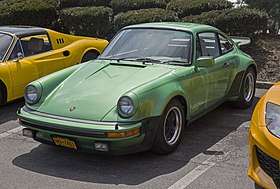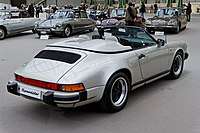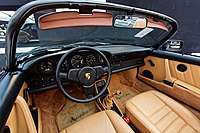Porsche 930
| Porsche 930 | |
|---|---|
 | |
| Overview | |
| Manufacturer | Porsche AG |
| Also called | Porsche 911 Turbo |
| Production |
|
| Assembly | Stuttgart, Zuffenhausen, West Germany |
| Body and chassis | |
| Class | Sports car (S) |
| Body style |
2-door 2+2 coupé 2-door 2+2 convertible 2-door targa 2-door speedster |
| Layout | Rear-engine, Rear wheel drive |
| Platform | Porsche G-series |
| Related | |
| Powertrain | |
| Engine | 3.0–3.3 L Single turbocharged and air-cooled flat-six |
| Transmission |
4-speed manual 5-speed manual |
| Dimensions | |
| Wheelbase | 89.4 in (2,272 mm) |
| Length | 168.9 in (4,291 mm) |
| Width | 69.9 in (1,775 mm) |
| Height | 51.6 in (1,311 mm) |
| Curb weight | 2,668–3,040 lb (1,210–1,379 kg)[1][2] |
| Chronology | |
| Predecessor | Porsche 911 Carrera RS 3.0 |
| Successor | Porsche 964 Turbo |
The Porsche 930 is a sports car built by Porsche between 1975 and 1989, known to the public as the 911 Turbo. It was the maker's top-of-the-range 911 model for its entire production duration and, at the time of its introduction, was the fastest production car available in Germany.
Model history
Porsche began experimenting with turbocharging technology on their race cars during the late 1960s, and in 1972 began development on a turbocharged version of the 911. Porsche originally needed to produce the car in order to comply with homologation regulations and had intended on marketing it as a street legal race vehicle like the 1973 Carrera 2.7 RS. The FIA's Appendix “J” rules that brought about the 911 Turbo Carrera RSR 2.1 in 1974 changed in 1975 and 1976. The FIA announced that cars for Group 4 and Group 5 had to be production cars and be available for sale to individual purchasers through manufacturer dealer networks. For the 1976 season, new FIA regulations required manufacturers to produce 400 cars within a twenty-four month period to gain approval for Group 4. Group 5 would require the car to be derived from a homologated model in Group 3 or 4. Porsche's Group 4 entry was the 934, homologated on 6 December 1975. For Group 5, Porsche would create one of the most successful racing cars of all time, the 935. The 911 Turbo was put into production in 1975. While the original purpose of the 911 Turbo was to gain homologation for the 1976 racing season, it quickly became popular among car enthusiasts. Four-hundred cars were produced by the end of 1975. Since Porsche wanted to be racing for the 1976 season, they gained FIA homologation for the Porsche Turbo for Group 4 in Nr. 645 on 6 Dec 1975 and the 1,000th 911 Turbo was completed on 5 May 1976.
Ernst Fuhrmann adapted the turbo-technology originally developed for the 917/30 CAN-AM car to the 3.0 litre flat-6 from the Carrera RS 3.0, creating what Porsche internally dubbed as the 930. The car utilises a single KKK turbocharger.[3]
Total output from the engine was 260 PS (191 kW; 256 hp) at 5,500 rpm and 329 N⋅m (243 lb⋅ft) of torque at 4,000 rpm, much more than the standard Carrera. With a compression ratio of 6.5:1. In order to ensure that the platform could make the most of the higher power output, a revised suspension, larger brakes and a stronger gearbox became part of the package, although some consumers were unhappy with Porsche's use of a four-speed transmission whilst a five-speed manual transmission was available in the "lower trim" Carrera. A "whale tail" rear spoiler was installed to help vent more air to the engine and to create more downforce at the rear of the vehicle, and wider rear wheels with upgraded tyres combined with flared wheel arches in order to increase the Turbo's width and grip, making it more stable.

Porsche badged the vehicle simply as "Turbo" (although early U.S. units were badged as "Turbo Carrera") and introduced the vehicle at the Paris Auto Show in October 1974 before putting it on sale in the spring of 1975; export to the United States began in 1976.
The 930 proved very fast but also very demanding to drive, and due to its short wheelbase and rear engine layout, was prone to oversteer and turbo-lag.
.jpg)
Porsche made its first and most significant changes to the 930 for 1978 model year, enlarging the engine bore by 2 mm (0.08 in) to a total displacement of 3,299 cc (3.3 L; 201.3 cu in) and adding an air-to-air intercooler. By cooling the pressurized air charge, the intercooler helped increase power to 300 PS (221 kW; 296 hp) at 5,500 rpm and 412 N⋅m (304 lb⋅ft) of torque at 4,000 rpm (DIN); the rear 'whale tail' spoiler was re-profiled and raised slightly to make room for the intercooler and the spoiler was now called the 'tea tray' spoiler. The hydraulic clutch was also more civilised. The suspension benefitted from new anti-roll bars, firmer shock absorbers and larger diameter rear torsion bars. Porsche also upgraded the brakes to units similar to those used on the 917 race car. While the increase in displacement and addition of an intercooler increased power output and torque, these changes also increased the weight of the vehicle, especially the engine, which contributed to a substantial change in the handling and character of the car compared to the earlier 3.0-litre models.
Changing emissions regulations in Japan and the U.S. forced Porsche to withdraw the 930 from those markets in 1980. It remained, however, available in Canada. Believing the luxurious 928 gran turismo would eventually replace the 911 as the top of the Porsche line, Fuhrmann cut back further development on the model, and it was not until his resignation that the company finally committed the financing to re-regulate the car.
The 930 remained available in Europe, and for 1983 a 335 PS (246 kW; 330 hp) performance option became available on a build-to-order basis from Porsche. With the add-on came a four-pipe exhaust system and an additional oil-cooler requiring a remodelled front spoiler and units bearing the add-on often featured additional ventilation holes in the rear fenders and modified rockers.
By the 1985 model year, 928 sales had risen slightly, but the question remained as to whether it would supersede the 911 as the company's premier model. Porsche re-introduced the 930 to the Japanese and U.S. markets in 1986 with an emission-controlled engine producing 282 PS (207 kW; 278 hp). At the same time Porsche introduced targa and cabriolet variants, both of which proved popular.
Porsche discontinued the 930 after model year 1989 when its underlying "G-Series" platform was being replaced by the 964. In that year, Porsche introduced the 930 Speedster, a variant featuring body style akin to the 356 Speedster, the Speedster featured a humped rear end with a "double bubble" roof storage compartment and a short, raked windshield along with a manually operated soft top. Only a handful of examples were produced making it one of the most rare 930 variants alongside the slantnose. The 1989 models were the first and last versions of the 930 to feature the G50 five-speed manual transmission. A turbo version of the 964 officially succeeded the 930 in 1991 with a modified version of the same 3.3 litre flat-six engine and a five-speed transmission.
Flatnose (Slantnose 930S)
In the late 1970s, Porsche tuners such as Ruf and Kremer (and others) began modifying customer cars with the “slant nose” front ends popularized by the factory racing 935s. Not a company to miss an obvious opportunity, in 1981 Porsche announced its own special-order slant nose front-end treatment. Originally available only in Europe, the 930S was then included as part of Porsche’s 1985 program to make its full range of cars and accessories available worldwide.
Porsche offered a "Flachbau" ("flatnose" or "slantnose") 930 under the "Sonderwunschprogramm" (special order program) beginning in 1981, an otherwise normal 930 with a 935-style slantnose instead of the normal 911 front end with the replacement of the famous "bug eye" headlamps with flip up units. Each Flachbau unit was handcrafted by remodeling the front fenders (option code M505). So a limited number of units were produced due to the fact that the package commanded a high premium price, and an initial premium of up to 60 per cent (highly individualized cars even more) over the standard price. 948 units were built in total. The Flachbau units delivered in Europe usually featured the 335 PS (246 kW; 330 hp) performance kit. The flat nose greatly contributed to the aerodynamics of the car and enabled it to accelerate from 0–60 mph in 4.6 seconds and attain a top speed of 173 mph (278 km/h).
Performance data
| Performance data: Porsche 930 European version | |||||||
| Model | 0-60 mph | 0–100 km/h | 0–160 km/h (100 mph) |
0–200 km/h | 1/4 mile | 1 km | Top speed |
|---|---|---|---|---|---|---|---|
| 1975 930 turbo 260 bhp | 5.2 s | 5.2 s[1] | 11.8 s[1] | 19.8 s[1] | ? | 24.2 s | 250 km/h (155.3 mph)[1] |
| 1978 930 turbo 300 bhp | 5.0 s[4] | 5.4 s[5] | 11.9 s[4] | 19.7 s[5] | 13.7@106.5[4] | 24.4 s[5] | 260.9 km/h (162 mph)[5] |
| 1983 930 turbo 330 bhp Flachbau | 4.7 s | 4.85 s | ? | ? | ? | ? | 275 km/h (171 mph) |
| 1984 930 turbo 330 bhp | 4.6 s | 4.8 s | 11.6 s | 17.7 s | ? | 23.8 s | 278 km/h (173 mph) |
| 1989 930 turbo 5-speed | 4.9 s[6] | 5.1 s | 12.0 s[7] | 20.4 s[7] | 13.6 | 24.6 s[7] | 260 km/h (162 mph)[7] |
| Performance test results: Porsche 930 US version | ||||||||
| Model | 0-30 mph | 0-50 mph | 0-60 mph | 0-80 mph | 0–100 mph | 0–120 mph | 1/4 mile | Top speed |
|---|---|---|---|---|---|---|---|---|
| 1975 930 turbo 234 bhp | 1.9 s[8] | 3.7 s[8] | 4.9 s[8] | 7.9 s[8] | 12.9 s[8] | ? | 13.5@103[8] | 156 mph (251 km/h)[8] |
| 1978 930 turbo 261 bhp | 2.1 s[9] | 3.6 s[9] | 4.9 s[9] | 7.5 s[9] | 12.1 s[9] | ? | 13.7@104.2[9] | 165 mph (266 km/h)[9] |
| 1986 930 turbo 282 bhp | 1.6 s[2] | 3.3 s[2] | 4.6 s[2] | 7.3 s[2] | 11.9 s[2] | 18.9 s[2] | 13.1@105[2] | 155 mph (250 km/h)[2] |
| 1987 930 turbo cabriolet 282 bhp | 1.7 s[10] | 3.7 s[10] | 4.9 s[10] | 8.4 s[10] | 13.0 s[10] | 20.6 s[10] | 13.5@102[10] | 150 mph (242 km/h)[10] |
Car and Driver recorded a 0-60 mph time of 4.9 seconds for both the 1975 and 1978 Porsche 911 Turbo, they shared first place in the "quickest cars of the 1970s" ranking with a 0.4 second lead.[11]
Gallery
_Speedster_convertible_04.jpg)



.jpg)
.jpg)
Notes
- 1 2 3 4 5 Auto, Motor und Sport 11/1975
- 1 2 3 4 5 6 7 8 9 "Car and Driver January 1986" (PDF). Retrieved February 24, 2016.
- ↑ "Porsche 911 Turbo". Retrieved 26 May 2018.
- 1 2 3 Road & Track September 1984
- 1 2 3 4 Auto, Motor und Sport 9/1978
- ↑ Car March 1989
- 1 2 3 4 Auto, Motor und Sport 3/1989
- 1 2 3 4 5 6 7 "Car and Driver December 1975" (PDF). Retrieved March 12, 2016.
- 1 2 3 4 5 6 7 "Car and Driver April 1978". Retrieved March 12, 2016.
- 1 2 3 4 5 6 7 8 "Car and Driver September 1987" (PDF). Retrieved March 16, 2016.
- ↑ "Car and Driver Tested: The 10 Quickest Cars of the 1970s". Retrieved 2016-02-29.
References
- Bongers, Marc (2004). Porsche - Serienfahrzeuge und Sportwagen seit 1948 (first edition). Motorbuch Verlag. ISBN 3-613-02388-1
- Peter Vann and C Beker, M Jurgens, M Kockritz, E Schimpf (2004). Porsche Turbo - The full History of the Race and Production Cars. Motorbooks International, USA. ISBN 0-7603-1923-5
| Wikimedia Commons has media related to Porsche 930. |
Porsche road car timeline, 1948–1990s — next » | ||||||||||||||||||||||||||||||||||||||||||||||||||||
|---|---|---|---|---|---|---|---|---|---|---|---|---|---|---|---|---|---|---|---|---|---|---|---|---|---|---|---|---|---|---|---|---|---|---|---|---|---|---|---|---|---|---|---|---|---|---|---|---|---|---|---|---|
| Type | 1940s | 1950s | 1960s | 1970s | 1980s | 1990s | ||||||||||||||||||||||||||||||||||||||||||||||
| 8 | 9 | 0 | 1 | 2 | 3 | 4 | 5 | 6 | 7 | 8 | 9 | 0 | 1 | 2 | 3 | 4 | 5 | 6 | 7 | 8 | 9 | 0 | 1 | 2 | 3 | 4 | 5 | 6 | 7 | 8 | 9 | 0 | 1 | 2 | 3 | 4 | 5 | 6 | 7 | 8 | 9 | 0 | 1 | 2 | 3 | 4 | 5 | 6 | 7 | 8 | 9 | |
| Roadster & sports cars | 912 | 912E | 924 | Boxster (986) | ||||||||||||||||||||||||||||||||||||||||||||||||
| 356 | 914 | 944 | 968 | |||||||||||||||||||||||||||||||||||||||||||||||||
| 911 series | 911 | 911 / 930 | 911 (964) | 911 (993) | 911 (996) | |||||||||||||||||||||||||||||||||||||||||||||||
| GT | 928 | |||||||||||||||||||||||||||||||||||||||||||||||||||
| Supercar | 959 | 911 GT1 Straßenversion | ||||||||||||||||||||||||||||||||||||||||||||||||||